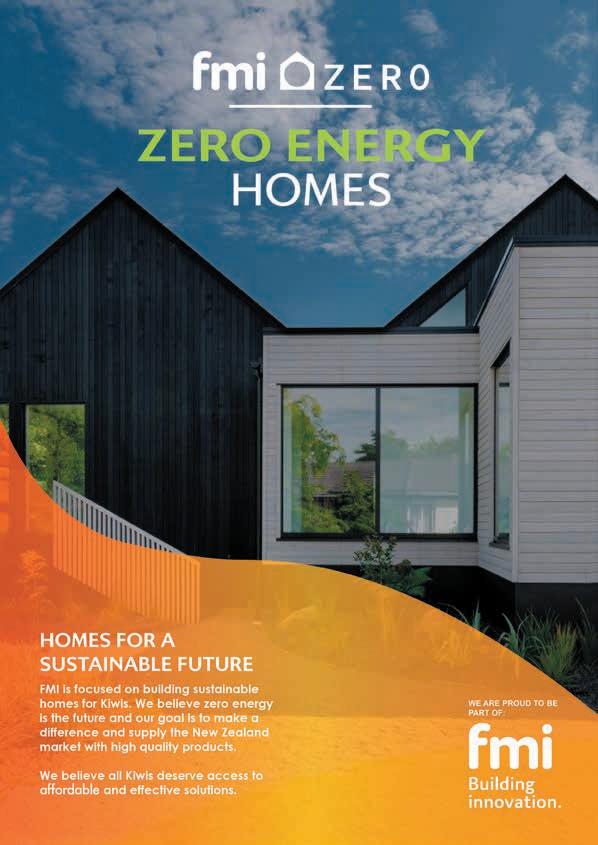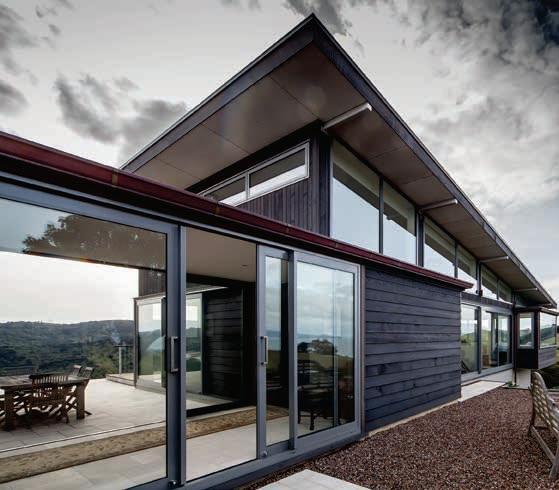
7 minute read
What are Super Windows ?
The ideal residential window will have very low heat loss year-round, collect passive solar energy in the winter and reject solar gain in summer, while allowing the desired daylight and view. Super Windows achieve this. They are an advanced insulating system that uses state-of-the-art glazing to secure special, lightweight films between glass panes. The films are coated with tiny particles of metal to create a mirrored finish and the spaces between the films create insulating chambers.
Performance Criteria for Zero Energy Windows
Advertisement
Following are the properties necessary for windows to have zero impact on the energy use in a typical house (i.e., a Zero Energy Window). Highly insulating window development efforts often focus on the development of an insulating glass unit with center-of-glass R-Value of 1.75 a target which can be achieved with three layers of glass, two low-e coatings and a low-conductivity gas fill. Spacer and frame effects can be expected to degrade this performance as such a total window R-Value of 1.45 is targeted as being a realistic long-term product for ZEHs.
The Science of Heat Mirror Technology
Heat Mirror® technology was invented by scientists at the Massachusetts Institute of Technology and was rated as one of the top 100 inventions of the past thousand years. In essence, one or more lightweight films are suspended inside the airspace of an insulating glass unit to create multiple “superinsulating” chambers. The films utilize nanoscale coatings of metal to reflect heat back to its source. The technology can be combined with a wide range of glass types and gas fills that allow consumers and architects to choose the right level of insulation, visible light, and solar control for their specific needs.
All this provides outstanding winter insulation and superior solar control that results in year-round energy savings and enhanced comfort you can feel. Depending on the number of films and the type of inert gases added within, Heat Mirror can achieve R-values ranging from 1.0 to 3.5, which can insulate as well as typical walls.
Heat Mirror® Technology
• Reduced heat loss in winter months keeps homes warmer in the winter. • The reduced solar heat gain in summer months keeps home cooler in the summer.
• UV blocking reduces fading to flooring, upholstery and other household items.
• Condensation resistance protects window trim and walls from moisture damage. • Reduced sound transmission minimises noise.

Vacuum IG - glass that insulates like a wall
Vacuum IG breaks through today’s expectations for glass performance and meets tomorrow’s demands for energy efficiency. Vacuum IG not only helps your project meet stringent codes but moves the planet forward reining in energy use.

• Up to 70% light transmission • Thermal insulation as high as
R1.4
• Safety & security: Tempered, laminated or both
• Sound control: Controls sound from external sources
• Easy to retrofit: For historical buildings as well as new construction
Achieving R-2.5 performance Quad Glazed IGU using 1.6mm glass
Vacuum IG’s revolutionary design takes two glass panes and seals them airtight. A vacuum is created in the space between two panes. With no air or gas between the panes, heat has no medium by which to transfer. The Vacuum IG design, along with Solace low-E coatings, can achieve thermal insulation performance as high as R-2.5.

Researchers Develop New ‘Super Window’
Thanks to the flat screen TV industry advances in thin glass technology, the creation of a new type of window is now possible.
A new generation of high-performance window makes use of extremely thin glass that can be incorporated into a triple-glazed window no thicker than a standard double-pane window.
Researchers at the Lawrence Berkeley National Laboratory (LBNL) have developed a new type of triple glazing for windows that is about the same thickness and weight as a standard low-e double-glazed window but comes with twice the insulating value.
The glass, just 0.7 mm thick, is used for the center pane in the triple-glazed assembly which can deliver high R-value without a redesigned window sash or frame. Argon gas which is typically used in double-glazed units is replaced by Krypton gas which is 6 times denser.
High-performance triple-glazed windows, such as those used in Zero Energy buildings, are readily available but they are thicker and heavier than standard doubleglazed units and until now, builders have to order them from Europe, extending construction schedules or requiring careful planning.
The windows have a center-of-glass R-value of between R-1.4 and R-1.75, about twice that of the best low-e double-glazed windows currently on the market.

The benefits of a drop-in replacement
LBNL researcher Stephen Selkowitz noted the following: The availability of a high-performance drop-in replacement for double-glazed sash could lower risks for manufacturers who want to begin making triple-glazed units.
As a ‘drop in’ insert with virtually the same weight and width as the existing [insulated glass unit], the barriers and risks of market entry to the window manufacturer are much lower and the major added cost is the marginal cost of the extra sheet of glass, the [krypton] gas fill, and a second low-e coating plus some additional assembly. Where the new windows replaced existing doubleglazed units, payback would come in 5 to 7 years.
He believes the market will go beyond mere price comparisons and consider other important benefits and value: improved thermal comfort, larger windows with better views with no penalty in energy, the potential for downsizing HVAC, and eliminating duct runs to the perimeter, etc.
Another advantage would be eliminating shipping costs and time delays that come with ordering highperformance triple-glazed windows from Europe.
The LBNL super-window is similar in design to windows made by using Heat Mirror, a polyester-based film manufactured by Eastman Chemical, instead of glass as the center pane. Selkowitz believes the thin glass will simplify the assembly process and lower costs.
Technology
This highly insulating glazing project focuses on the development of alternative Center glazing layers for multiple low-e/ gas-filled units. The aim is to increase the number of technological options available to industry for center glazing layers. The two options in use today, suspended films and triple glazed glass units with low-emissivity coatings and/or insulating gas fills, are technologies that have been in use for over two decades. Using lightweight, thin, non-structural layers, the focus of this project, offers several potential manufacturing and performance advantages:
A single piece spacer is possible, reducing labor and material costs and potential for gas fill leakage.
No significant weight changes over industry standard double-pane units, thus minimal or no changes in standard operating hardware
Thinner center layer allows products to fit in existing cross-sections, reducing the need for revised framing systems.
Pressure equalization between the internal gaps is possible, reducing potential glass deflection.
The concept of the “drop-in replacement” IGU simplifies adoption of the new technology but at some sacrifice in performance. We explore in this project how use of existing frames will constrain overall performance. Centre-of-glass performance much better than that obtained by thin-triple-pane IGU designs will not result in much whole window performance improvement without further enhancements to typical frames.
Several IR experiments on uninsulated and insulated edge cases pointed out the importance of edge insulation in minimizing edge deflection. Understanding the impacts of deflection in standard and non-standard three layer units is important both to highly insulating window development and ratings and labelling efforts.

Known as the green metal, aluminium is one of the most environmentally friendly metals because of its sustainability. Over the past 53 years FMI Building Innovation has perfected the craft of manufacturing thousands of extruded aluminium profiles and the art of bringing them to life with textures and colours.
Our latest super tough powder coat technology, AEONOX, is a scratch-resistant formula designed to minimize the risk of profile damage throughout the installation and manufacturing process. FMI’s own powder coating plant utilizes the latest technology in electro-static heat-treated powder coating and is accredited to WANZ Enduro Colour Powder Coating Quality standards.
The subtle colour range has been increased to harmonise with a wide range of styles and tastes.





